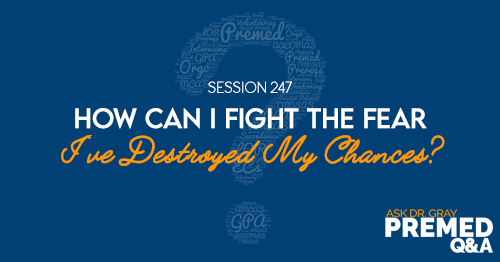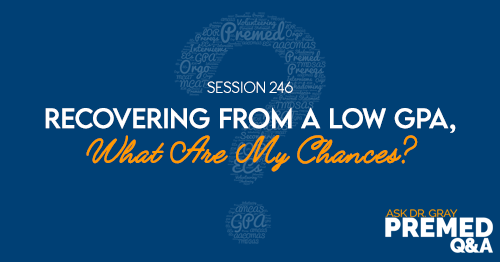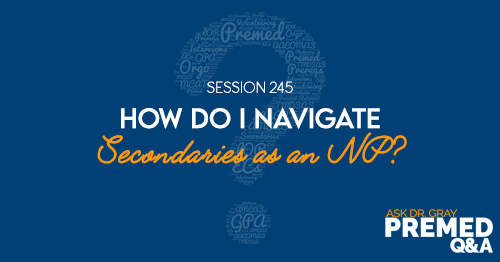Apple Podcasts | Google Podcasts
Session 155
This premed had a downward trend in undergrad but is currently in a postbac program. Can she overcome her trend or does she need an SMP?
Ask Dr. Gray: Premed Q&A is brought to you by Blueprint MCAT. Listen to this podcast episode with the player above, or keep reading for the highlights and takeaway points.
The episodes in this podcast are recordings of our Facebook Live that we do at 3 pm Eastern on most weekdays. Check out our Facebook page and like the page to be notified. Also, listen to our other podcasts on MedEd Media. If you have any questions, call me at 617-410-6747.
[00:22] Question of the Day
“I wanted to talk about my DIY Postback. Okay. So just for some background info, I graduated in spring 2020. My science GPA was below 3.0. But my cumulative was about 3.1. I am currently in the third semester of my postbac. But I’m having a little bit of some concerns about it.
My first concern is that my cumulative GPA and my science GPA and undergrad were a complete downward trend. And I’m, I’m a bit discouraged that although I’m in a DIY postbac right now, that negative or downward trend might still be overshadowing everything else on my application.”
[01:56] No Control Over the Past
There’s nothing you can do about the downward trend from your undergrad pre-postbac. The only thing that you can do right now is focusing on the grades of the courses that you’re in to get the grades necessary to overshadow that downward trend.
'You can't control how a medical school is going to review your application with that downward trend.'Click To TweetThe only thing that you can do is put your best foot forward every single day from here on out and show the medical schools that the downward trend was just a blip. And that’s not the student who they are going to get when they accept you.
[02:19] SMP vs. Postbac
Our student is thinking of applying to a linkage SMP. But you don’t need to do an SMP. It’s almost always one or the other. There are very few exceptions where someone does a postbac program, whether a do-it-yourself postbac or formal postbac and doesn’t do well in that postbac. And then as the final lifeline, they go and do an SMP program.
“An SMP and a postbac both fulfill the same purpose – to prove academic capability.”Click To TweetIf you’re doing well in your postbac program, save the $50k for the SMP. Do well on the MCAT and apply to medical school.
Unfortunately, these programs dangle this linkage out there advertising stuff like it’s going to be even easier for you to get into medical school. And it’s not the case because you still have all the pressure of doing well in that SMP program.
[04:30] Doing the Math
Ideally, you want to get above a 3.0 but you have to do the math. if it’s going to take you 10 years to get above a 3.0, then it’s not worth it.
'The trend is what you should be focusing on more than that final number.'Click To TweetAbove a 3.0 is the general kind of rule of thumb that everyone gives out, but it’s not a hard and fast rule that everyone has to follow and that every medical school is going to filter you out based on.
So if you can get the courses that you need to have 30-40 credits as close to a 4.0 as possible, that’s great.
[05:30] The Financial Piece
What’s concerning is our student is saying she could be doing better. And she explains she has other responsibilities other than the postbac. She is currently doing a part time job at a medical school to help pay for the classes. On top of that, she has other family responsibilities.
Her GPA for her postbac is around 3.5, which is still not stellar. And if she were to do an SMP, she wouldn’t be working and be focusing on school. And that’s because she will be getting financial aid because it’s a master’s based program.
That’s always the biggest difference between undergrad postback and SMPs or any other sort of master’s program is that financial aid piece.
The rare exception of students who go to a postbac and then do an SMP, it’s almost always for that same specific reason that they’re doing their postbac and they have to work to pay for it on top of the family they have to take care of. And so, they can’t dedicate themselves to the postbac program. They don’t have the bandwidth to prove academic capability in the program they’re supposed to be doing to prove academic capability.
That is almost always the case where I see students do a postbac first and then do some sort of master’s program after.
Ultimately, it’s up to you. If you feel like you’re going to be better suited doing an SMP not because of a linkage, but because it will allow you to stop working so that you can focus almost exclusively on your courses, then go for it. Stop doing the postbac and go for the SMP. The biggest warning though is you have to get as close to a 4.0 as possible.
[08:07] Lumping Hours into One Activity
Our student mentions having a cumulative number of hours doing community service. And she’s wondering if it would be more important to have one main community service event that she has done throughout the years or just a cumulative number of hours doing different things.
It ultimately doesn’t matter because it’s a super nitty-gritty question that almost every medical school is just not going to care about.
In terms of listing your activities, just remember that you’re limited in terms of spaces for the AMCAS application with only 15 spots. Now, for the AACOMAS application, there’s no limit as well as the TMDSAS application, so you could put each activity with its corresponding number of hours. And so, the limiting factor is the number of spots on the AMCAS application.
That being said, there are no rules when it comes to how you do this. If there was one activity that stood out amongst all the rest, you could theoretically put that on its own. And that was 10 hours and the other 90 hours go into one other activity. You say you were involved in lots of different things and you’re just going to tell a story of one of the most important ones.
This comes up a lot with college athletes because usually as part of their athletic responsibilities is community service. Same thing with Greek life, fraternities, sororities, etc. They do a lot of little community service things and they just put that in their application as general volunteering and they’re not listing every little thing in the activity description. They just say that as part of their sorority, they were involved in many volunteer opportunities, and the one that stands out the most is X, Y, or Z.
[11:06] Clinical or Not Clinical
Our student apparently works at a medical school part-time in the COVID. Lab. When she was offered the position, she was told it was a clinical experience. But she realized she’s not working with patients. And so, she isn’t sure how to list that in her work and activity section.
At the medical school, they’re taking the COVID samples and running PCR of the faculty and students. If you’re not interacting at all with the patient, I wouldn’t call it clinical. But you could write it as clinical as there are no rules and just let the medical schools decide.
[12:57] Focusing on the MCAT
Our student says she’s planning on taking another semester of classes for her postbac. After reading The Premed Playbook: Guide to the Medical School Application Process, she realized that the MCAT is almost like a three-credit course. So she wanted to cut down on her classes. Maybe just take one class so she could focus on the MCAT.
Now, she’s worried about managing her time with work, and bringing it down to one class, and focusing on the MCAT. But if you’re going to do the SMP, what’s the point in paying for a class that you don’t need and taking time away from studying for the MCAT? Ultimately, you don’t need to take the course and just focus on the MCAT. Sign up for a free account at Blueprint MCAT and get access to their amazing resources.
A little side note here:
One of the reasons I don’t like SMPs and other master’s programs specifically tailored for premed students, is they require an MCAT for admission. The whole point of an SMP and a postbac program is to solidify your knowledge and understanding of the sciences. Get good grades to prove academic capability, and use that newly-found foundation to do well on the MCAT.
Unfortunately, these programs flip it and they’re basically gaming the system. They want you to prove to them that you’re going to do well in their courses by doing well on the MCAT.
And so, they’re telling you to take the MCAT first because they want to screen out people who are going to do well in their courses. So they’re just gaming the system and gaming their numbers. They claim they have a 95% success rate in getting students into medical school. But that’s only because they filtered out everyone who struggled with the MCAT. They made them take the MCAT early because they didn’t have the solid foundation that these programs were supposed to teach them.
[16:07] Going to a Community College: Is It a Red Flag?
Aware that taking courses at a community college is frowned upon in the premed community, she’s worried about mentioning this in her personal statement or her secondary essays. But it’s not a red flag at all. A lot of students go to community college and there are lots of reasons people go to community college.
Links:
Medical School HQ Facebook page
Medical School HQ YouTube channel
Instagram @MedicalSchoolHQ
Join the Application Academy!
The Premed Playbook: Guide to the Medical School Personal Statement
The Premed Playbook: Guide to the Medical School Application Process
SEARCH SITE
LISTEN FOR FREE












